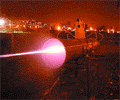|
|
| 07 May 2004 The leading online resource for
the engineering industry |
From The Engineer, 29 April 2004
Laser laboratory
 By Joe Boyle
By Joe Boyle
Airborne
biological warfare agents can be detected at long range by a short burst
from a high-powered laser, according to French researchers.
The method
could replace the time-consuming process of sending an aircraft to collect
air samples and then conducting a lengthybiochemical analysis.
Researchers
at the University of Lyon believe their laser could be fired at a suspect
cloud, and the emission analysed instantaneously for fluorescent molecules
such as riboflavin, a harmless vitamin found in anthrax and other agents.
The fluorescence signature of riboflavin would immediately signal the presence
of biological warfare agents.
During
an experiment in Lyon a water-based aerosol doped with riboflavin was sprayed
into the air. A terawatt (one trillion watts) laser was then fired towards
the sample in femtosecond bursts and a telescope collected the reflected
light and scattered signals. The information from the riboflavin-doped cloud
was then compared with that from a pure water aerosol. The fluorescence of
riboflavin was clearly detected by the laser.
But the
Lyon researchers broke new ground by doubling the wavelength of the light
pulses. Instead of one photon from the laser being used to excite the fluorescence
in one molecule of riboflavin, two photons were used for each molecule.
Whereas
the one-photon method failed to detect fluorescent molecules beyond 2km
away, the two-photon method was effective up to 4km from the laser.
Prof Jean-Pierre
Wolf of the physics department at the university, who conducted the research,
said the detection method will have two phases of development. 'If you see
an aircraft which has suddenly released some strange aerosol or exhaust,
you can just shoot the laser into the cloud and see instantly if it is biological
or not.
This is
the first stage, and could be ready to use in two years,' he said. 'The
next stage will be to analyse all the air. At the moment it is very difficult
because bacteria is everywhere, so we cannot always be sure that something
is really a pathogen. This might take 10 years or more to develop,' he said.
Wolf's work is part of
the Teramobile research project, conducted jointly by France and Germany.
The Teramobile laser is also being used to research effective channelling
of lightning, to ensure airport and power station safety. The project is
funded by the National Centre of Scientific Research (CNRS) in France and
the German Research Foundation (DFG)
 By Joe Boyle
By Joe Boyle